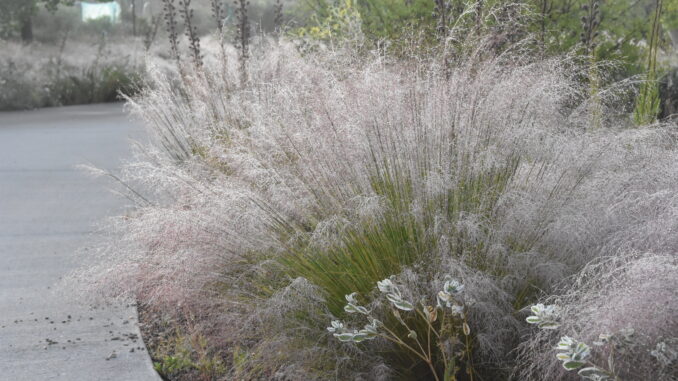

by Bryan Fischer, Curator, and Horticulturist, Gardens on Spring Creek
I have a working theory: grasses are an acquired taste for most gardeners. Overuse of a few cultivars and lack of a flashy bloom both seem to have contributed to an impressive apathy (or even disdain) towards these plants. But, as a gardener gains experience, they realize grasses offer something to the garden that perennials cannot match; superb textural contrast, an exceptional degree of plasticity for harsh weather, and four-season appeal.
Not only have I noticed my taste towards grasses change since first gardening on the Front Range as a kid, but my coworker Amanda, who patiently edits these articles, confessed that she, after a few years gardening here and shunning our “dry, brown grasses”, is also “starting to appreciate the grass thing”.
I can’t help but wonder if the blue grama Amanda and I selected for one of her new garden beds helped to sway her tastes. One of a few grass species that dominated the shortgrass prairie in the days before colonization, Bouteloua gracilis (blue grama) is supremely adapted to our region. With interesting, eyebrow-like seedheads in late summer that sit perpendicular to their upright stems and a fine-textured tuft of foliage below, this native is quite handsome, too. ‘Blonde Ambition’, a clumping selection by the late and great David Salman offers the best of these features in a larger, more attractive plant. Expect it to take a vase shape during bloom, reaching three feet high and two feet wide in sun.
Though slightly less common in the trade – thus far, Muhlenbergia reverchonii UNDAUNTED™ has proven equally appealing to garden visitors. This vigorous selection of the species by Lauren Springer and Scott Ogden hails from seasonal seeps in Texas, where groundwater seasonally reaches the soil surface before drying for months at a time. Perhaps as a result of this origin of extremes, these plants are adaptable, happily growing quite dry to seasonally wet, and have proven themselves hardier than their Southern origins might suggest. While slow to get going in spring, they draw visitors like moths to a flame in early fall thanks to glowing, see-through clouds of mulberry-colored blooms. Plant them en masse for the best effect and expect each plant to reach two feet high and three feet wide in full sun.
While not technically a grass, Carex appalachica (Appalaichan sedge) is one of the best graminoid (a grass or grass-like plant) textural additions to shade gardens in our region. With a chartreuse green color, it brightens such spaces easily through the summer and self-sows lightly if sited well. Aplomb in dry shade, one of our toughest design situations, I’ve used this plant liberally in all my home gardens. Smaller than the above offerings, these plants will remain around eight inches tall and wide, allowing for their use as a groundcover or accent at bed edges, or as an attractive in-bed weed smother. With additional watering, Appalachian sedge will adapt to part and full-sun sites, too.
The sheer diversity of grasses can make diving into their use intimidating. The reality of growing them, however, is that they generally are among the most easygoing of our garden plants, and offer a suite of traits – unusual textures, forms, and shapes, interesting movement, and tolerance for extreme weather – that flowering perennials can’t match. If you still aren’t convinced, take a stroll through the Gardens on Spring Creek, where a diversity of grasses is displayed year-round, including those mentioned above.
Support Northern Colorado Journalism
Show your support for North Forty News by helping us produce more content. It's a kind and simple gesture that will help us continue to bring more content to you.
BONUS - Donors get a link in their receipt to sign up for our once-per-week instant text messaging alert. Get your e-copy of North Forty News the moment it is released!
Click to Donate
